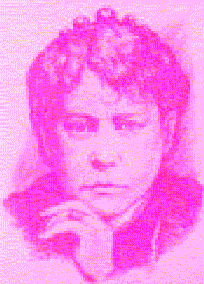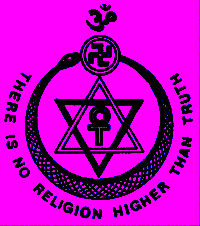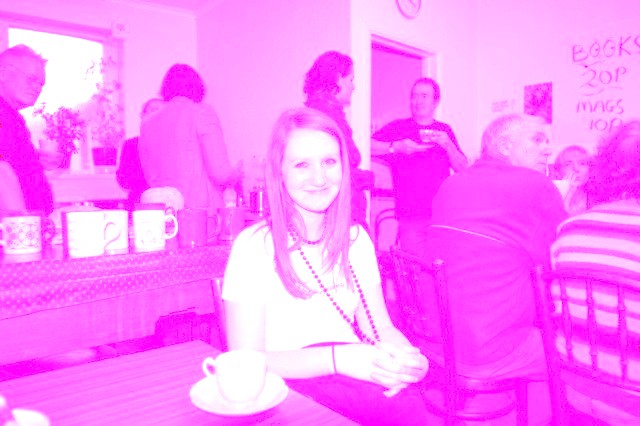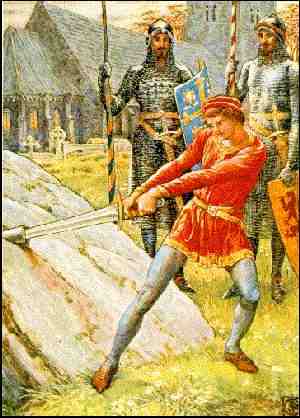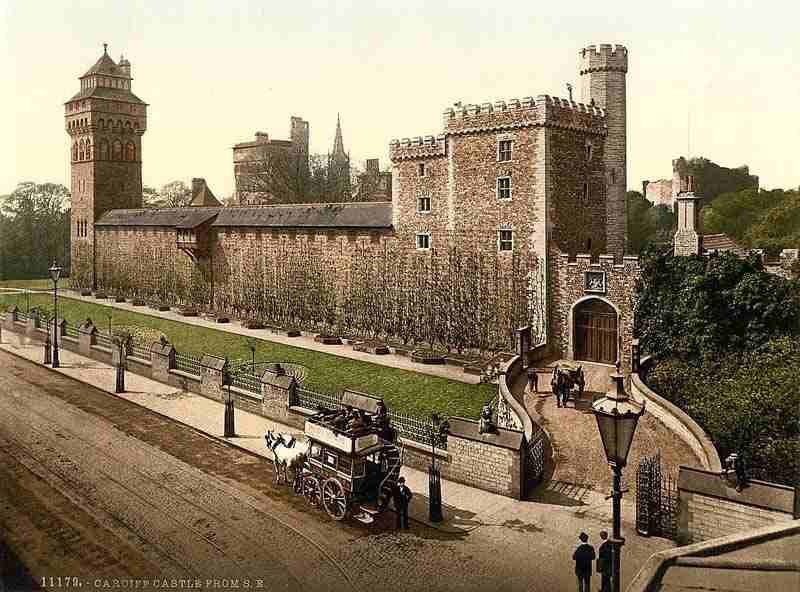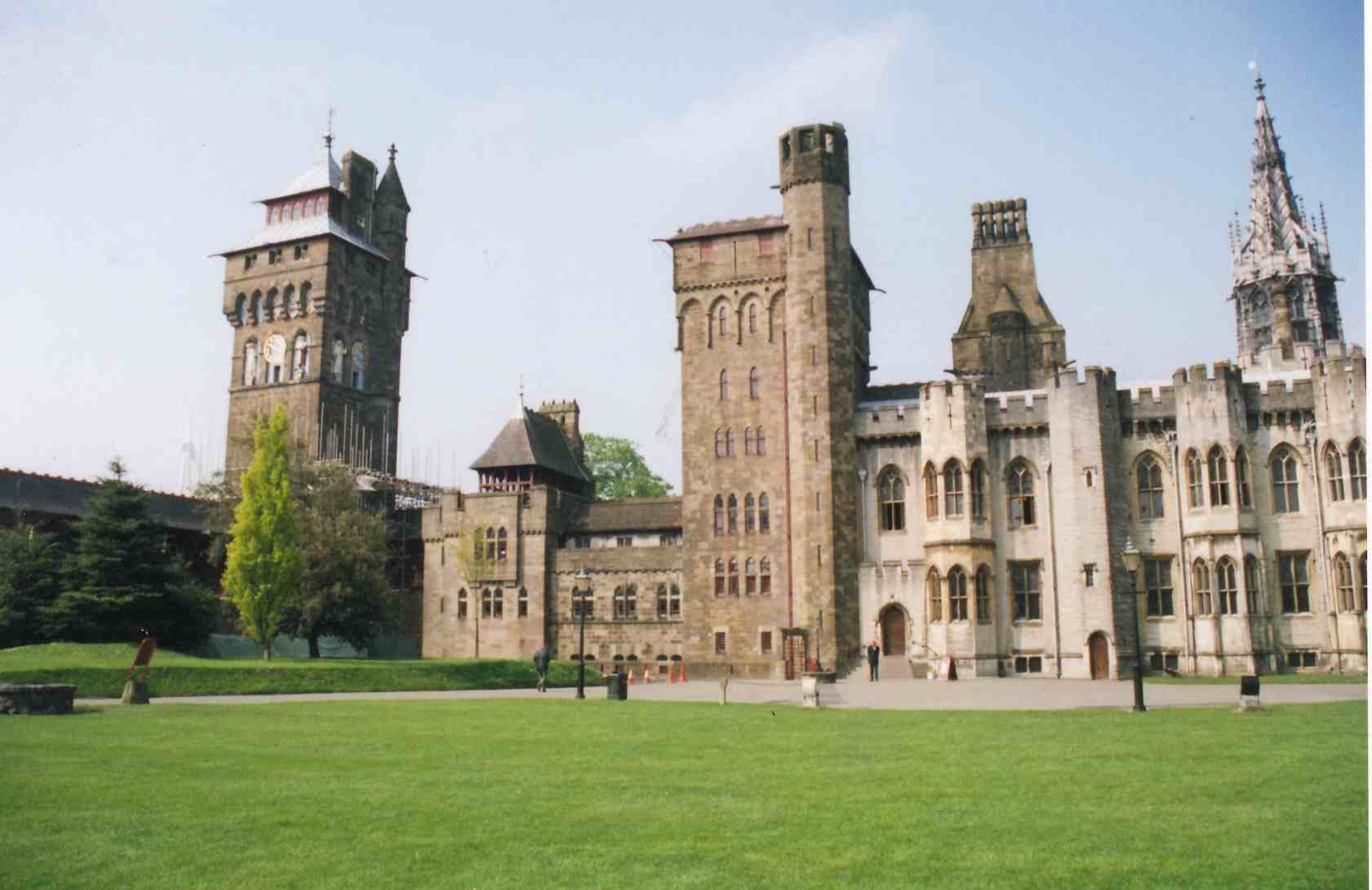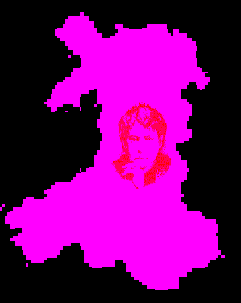
The All
Getting Started in Theosophy
(And it’s all
Free Stuff )
But you don’t
have to live in Wales
to find this guide useful
Helena Petrovna Blavatsky
1831 – 1891
____________________
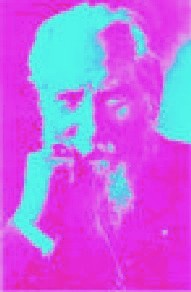
The
Constitution of Man
From
A
Textbook of Theosophy
By
C
W Leadbeater
Man is therefore in essence a Spark of the divine
Fire, belonging to the monadic world. (The President has now decided upon a set
of names for the planes, so for the future these will be used instead of those
previously employed. A table of them is given below for reference) To that
Spark, dwelling all the time in that world, we give the name “Monad”. For the
purpose of human evolution Monad manifests itself in lower worlds. When it
descends one stage and enters the spiritual world, it shows itself there as the
triple Spirit, having itself three aspects (just as in worlds infinitely higher
the Deity has His three Aspects.) Of those three - one remains always in that
world, and we call that the Spirit in man. The second aspect manifests itself
in the intuitional world, and we speak of it as the Intuition in man. The third
shows itself in the higher mental world, and we call it the Intelligence in
man. These three aspects taken together constitute the ego which ensouls the
fragment from the group-soul.
Thus man as we know him
New
Names & Old Names
1 Divine
World Âdi Plane
2 Monadic
World Anupâdaka
3
Spiritual World Âtmic or Nirvânic Plane
4
Intuitional World Buddhic Plane
5 Mental
World Mental Plane
6 Emotional or Astral World Astral Plane
7 Physical
World Physical Plane
reality a Monad residing in the monadic world, shows
himself as an ego in the higher mental world, manifesting these three aspects
of himself (Spirit, Intuition and Intelligence) through that vehicle of higher
mental matter which we name the casual body.
This ego is the man during the human stage of
evolution; he is the nearest correspondence, in fact, to the ordinary
unscientific conception of the soul. He lives unchanged (except for his growth)
from the moment of individualization until humanity is transcended and merged
into divinity. He is in no way affected by what we call birth and death; what
we commonly consider as his life is only a day in his life. The body which we
can see, the body which is born and dies, is a garment which he puts on for the
purposes of a certain part of his evolution.
Nor is it the only body which he assumes. Before he,
the ego in the higher mental world, can take a vehicle belonging to the
physical world, he must make a connection with it through the lower mental and
astral worlds. When he wishes to descend he draws around himself a veil of the
matter of the lower mental world, which we call his mental body. This is the
instrument by means of which he thinks all his concrete thoughts – abstract
thought being a power of the ego himself in the higher mental world.
Next he draws round himself a veil of astral matter,
which we call his astral body; and that is the instrument of his passions and
emotions, and also (in conjunction with the lower part of his mental body) the
instrument of all such thought as is tinged by selfishness and personal
feeling. Only after having assumed these intermediate vehicles can he come into
touch with a baby physical body, and be born into the world which we know. He
lives through what we call his life, gaining certain qualities as the result of
its experiences; and at its end, when the physical body is worn out, he
reverses the process of descent and lays aside one by one the temporary
vehicles which he has assumed.
The first to go is the physical body, and when that is
dropped, his life is centered in the astral world and he lives in his astral
body.
The length of his stay in that world depends upon the
amount of passion and emotion which he has developed within himself in his
physical life. If there is much of these the astral body is strongly vitalized,
and will persist for a long time; if there is but little, the astral body has
less vitality, and he will soon be able to cast that vehicle aside in turn.
When that is done he finds himself living in his
mental body. The strength of that depends upon the nature of the thoughts to
which he had habituated himself, and usually his stay at this level is a long
one. At last it comes to an end, he casts aside the mental body in turn, and is
once more the ego in his own world.
Owing to lack of development, he is as yet but
partially conscious in that world; the vibrations of its matter are too rapid
to make any impression upon him, just as the ultraviolet rays are too rapid to
make any impression upon our eyes. After a rest there, he feels the desire to
descend to a level where the undulations are perceptible to him, in order that
he may feel himself to be fully alive; so he repeats the process of descent
into denser matter, and assumes once more a mental, an astral and a physical
body. As his previous bodies have all disintegrated, each in its turn, these
new vehicles are entirely distinct from them, and thus it happens that in his
physical life he has no recollection whatever of other similar lives which have
preceded it.
When functioning in this physical world he remembers
by means of his mental body; but since that is a new one, assumed only for this
birth, it naturally cannot contain the memory of previous births in which it
had no part. The man himself, the ego, does remember them all when in his own
world, and occasionally some partial recollection of them or influence from
them filters through into his lower vehicles. He does not usually, in his
physical life, remember the experiences of earlier lives, but he does manifest
in physical life the qualities which those experiences have developed in him.
Each man is therefore exactly what he has made himself during those past lives;
if he has in them developed good qualities in himself, he possesses the good
qualities now; if he neglected to train himself, and consequently left himself
weak and of evil disposition, he finds himself precisely in that condition now.
The qualities, good or evil, with which he is born are those which he has made
for himself.
This development of the ego is the object of the whole
process of materialization; he assumes
those veils of matter precisely because through them he is able to receive
vibrations to which he can respond, so that his latent faculties may thereby be
unfolded.
Though man descends from on high into these lower
worlds, it is only through that descent that a full cognizance of the higher
worlds is developed in him. Full consciousness in any given world involves the
power to perceive and respond to all the undulations of that world; therefore
the ordinary man has not yet perfect consciousness at any level – not even in
this physical world which he thinks he knows. It is possible for him to unfold
his percipience in all these worlds, and it is by means of such developed
consciousness that we observe all these facts which I am now describing.
The causal body is the permanent vehicle of the ego in
the higher mental world. It consists of matter of the first, second and third
subdivisions of that world. In ordinary people it is not yet fully active, only
that matter which belongs to the third subdivision being vivified. As the ego
unfolds his latent possibilities through the long course of his evolution, the
higher matter is gradually brought into action, but it is only in the perfected
man whom we call the Adept that it is developed to its fullest extent. Such
matter can be discerned by clairvoyant sight, but only by a seer who knows how
to use the sight of the ego.
It is difficult to describe a causal body fully,
because the senses belonging to its world are altogether different from and
higher than ours at this level. Such memory of the appearance of a causal body as
it is possible for a clairvoyant to bring into his physical brain represents it
as ovoid, and as surrounding the physical body of the man, extending to a
distance of about eighteen inches from the normal surface of that body. In the
case of primitive man it resembles a bubble, and gives the impression of being
empty. It is in reality filled with higher mental matter, but as this is not
yet brought into activity it remains colorless and transparent. As advancement
continues it is gradually stirred into alertness by vibrations which reach it
from the lower bodies. This comes but slowly, because the activities of man in
the earlier stages of his evolution are not of a character to obtain expression
in matter so fine as that of the higher mental body; but when a man reaches the
stage where he is capable either of abstract thought or of unselfish emotion
the matter of the causal body is aroused into response.
When these rates of undulation are awakened within him
they show themselves in his causal body as colors, so that instead of being a
mere transparent bubble it gradually becomes a sphere filled with matter of the
most lovely and delicate
hues – an object beautiful beyond all conception. It
is found by experience that these colors are significant. The vibration which
denotes the power of unselfish affection shows itself as a pale rose-color;
that which indicates high intellectual power is yellow; that which expresses
sympathy is green, while blue betokens devotional feeling, and a luminous
lilac-blue typifies the higher spirituality. The same scheme of color
significance applies to the bodies which are built of denser matter, but as we
approach the physical world the hues are in every case by comparison grosser –
not only less delicate but also less living.
In the course of evolution in the lower worlds man
often introduces into his vehicles qualities which are undesirable and entirely
inappropriate for his life as an ego – such, for example, as pride,
irritability, sensuality. These, like the rest, are reducible to vibrations,
but they are in all cases vibrations of the lower subdivisions of their
respective worlds, and therefore they cannot reproduce themselves in the casual
body, which is built exclusively of the matter of the three higher subdivisions
of its world. For each section of the astral body acts strongly upon the
corresponding section of the mental body, but only upon the corresponding
section; it cannot influence any other part. So the casual body can be affected
only by the three higher portions of the astral
body; and the oscillations of those represent only good qualities.
The practical effect of this is that the man can build
into the ego (that is, into his true self) nothing but good qualities; the evil
qualities which he develops are in their nature transitory and must be thrown
aside as he advances, because he has no longer within him matter which can
express them. The difference between the causal bodies of the savage and the
saint is that the first is empty and colorless, while the second is full of
brilliant coruscating tints. As the man passes beyond even sainthood and
becomes a great spiritual power, his causal body increases in size, because it
has so much more to express, and it also begins to pour out from itself in all
directions powerful rays of living light. In one who has attained Adeptship
this body is of enormous dimensions.
The mental body is built of matter of the four lower
subdivisions of the mental world, and expresses the concrete thoughts of the
man. Here also we find the same color scheme as in the casual body. The hues
are somewhat less delicate, and we notice one or two additions. For example, a
thought of pride shows itself as orange, while irritability is manifested by a
brilliant scarlet.
We may see here sometimes the bright brown of avarice,
the grey-brown of selfishness, and grey-green of deceit. Here also we perceive
the possibility of a mixture of colors; the affection, the intellect, the
devotion may be tinged by selfishness, and in that case their distinctive
colors are mingled with the brown of selfishness, and so we have an impure and
muddy appearance. Although its particles are always in intensely rapid motion
among themselves, this body has at the same time a kind of loose organization.
The size and shape of the mental body are determined
by those of the causal vehicle. There are in it certain striations which divide
it more or less irregularly into segments, each of these corresponding to a
certain department of the physical brain, so that every type of thought should
function through its duly assigned portion. The mental body is as yet so
imperfectly developed in ordinary men that there are many in whom a great
number of special departments are not yet in activity, and any attempt at
thought belonging to those departments has to travel round through some
inappropriate channel which happens to be fully open. The result is that
thought on those subjects is for those people clumsy and uncomprehending. This
is why some people have a head for mathematics and others are unable to add
correctly – why some people instinctively understand, appreciate and enjoy
music, while others do not know one tune from another.
All the matter of the mental body should be
circulating freely, but sometimes a man allows his thought upon a certain subject to set and solidify, and
then the circulation is impeded, and there is congestion which presently
hardens into a kind of wart on the mental body. Such a wart appears to us down
here as a prejudice; and until it is absorbed and free circulation restored, it
is impossible for man to think truly or to see clearly with regard to that
particular department of his mind, as the congestion checks the free passage of
undulations both outward and inward.
When a man uses any part of his mental body it not
only vibrates for the time more rapidly, but it also temporarily swells out and
increases in size. If there is prolonged thought upon a subject this increase
becomes permanent, and it is thus open to any man to increase the size of his
mental body either along desirable or undesirable lines.
Good thoughts produce vibrations of the finer matter
of the body, which by its specific gravity tends to float in the upper part of
the ovoid; whereas bad thoughts, such as selfishness and avarice, are always
oscillations of the grosser matter, which tends to gravitate towards the lower
part of the ovoid.
Consequently the ordinary man, who yields himself not
infrequently to selfish thoughts to various kinds, usually expands the lower
part of his mental body, and presents roughly the appearance of an egg with its
larger end downwards. The man who has repressed those lower thoughts, and
devoted himself
to higher ones, tends to expand the upper part of his
mental body and therefore presents the appearance of an egg standing on its
smaller end. From a study of the colors and striations of a man’s mental body
the clairvoyant can perceive his character and the progress he has made in his
present life. From similar features of the causal body he can see what progress
the ego has made since its original formation, when the man left the animal
kingdom.
When a man thinks of any concrete object – a book, a
house, a landscape – he builds a tiny image of the object in the matter of his
mental body. This image floats in the upper part of that body, usually in front
of the face of the man and at about the level of the eyes. It remains there as
long as the man is contemplating the object, and usually for a little time
afterwards, the length of time depending upon the intensity and the clearness
of the thought. This form is quite objective, and can be seen by another
person, if that other has developed the sight of his own mental body. If a man
thinks of another, he
creates a tiny portrait in just the same way. If his
thought is merely contemplative and involves no feeling (such as affection or
dislike) or desires (such as a wish to see the person) the thought does not
usually perceptibly affect the man of whom he thinks.
If coupled with the thought of the person there is a
feeling, as for example of affection, another phenomenon occurs besides the
forming of the image. The thought of affection takes a definite form, which it
builds out of the matter of the thinker’s mental body. Because of the emotion
involved, it draws round it also matter of his astral body, and thus we have an
astro-mental form which leaps out of the body in which it has been generated,
and moves through space towards the object of the feeling of affection. If the
thought is sufficiently strong, distance makes absolutely no difference to it;
but the thought of an ordinary person is usually weak and diffused, and is
therefore not effective outside a limited area.
When this thought-form reaches its object it
discharges itself into his astral and mental bodies, communicating to them its
own rate of vibration. Putting this in another way, a thought of love sent from
one person to another involves the actual transference of a certain amount both
of force and of matter from the sender to the recipient, and its effect upon
the recipient is to arouse the feeling of affection in him, and slightly but
permanently to increase his power of loving. But such a thought also
strengthens the power of affection in the thinker, and therefore it does good
simultaneously to both.
Every thought builds a form; if the thought be
directed to another person it travels to him; if it be distinctly selfish it
remains in the immediate neighbourhood of the thinker; if it belongs to neither
of these categories it floats for awhile in space and then slowly
disintegrates.
Every man therefore is leaving behind him wherever he
goes a trail of thought-forms; as we go along the street we are walking all the
same amidst a sea of other men’s thoughts. If a man leaves his mind blank for a
time, these residual thoughts of others drifts through it, making in most cases
but little impression upon him.
Sometimes one arrives which attracts his attention, so
that his mind seizes upon it and makes it its own, strengthens it by the
addition of its force, and then casts it out again to affect somebody else. A
man, therefore, is not responsible for a thought which floats into his mind,
because it may be not his, but someone else’s, but he is responsible if he
takes it up, dwells upon it and then sends it out strengthened.
Self-centered thought of any kind hangs about the
thinker, and most men surround their mental bodies with a shell of such
thoughts. Such a shell obscures the mental vision and facilitates the formation
of prejudice.
Each thought-form is a temporary entity. It resembles
a charged battery, awaiting an opportunity to discharge itself. Its tendency is
always to reproduce its own rate of vibration in the mental body upon which it
fastens itself, and so to arouse in it a like thought. If the person at whom it
is aimed happens to be busy, or already engaged in some definite train of
thought, the particles of his mental body are already swinging at a certain
determinate rate, and cannot for the moment be affected from without. In that
case the thought-form bides its time, hanging about its object until he is
sufficiently at rest to permit its entrance; then it discharges itself upon
him, and in the act ceases to exist.
The self-centered thought behaves in exactly the same
way with regard to its generator, and discharges itself upon him when
opportunity offers. If it be an evil thought he generally regards it as the
suggestion of a tempting demon, whereas in truth he tempts himself. Usually
each definite thought creates a new thought-form; but if a thought-form of the
same nature is already hovering round the thinker, under certain circumstances
a new thought on the same subject, instead of creating a new form, coalesces
with and strengthens the old one, so that by long brooding over the same
subject a man may sometimes create a thought-form of tremendous power. If the
thought be a wicked one, such a thought-form may become a veritable evil
influence, lasting perhaps for many years, and having for a time all the
appearance and powers of a real living entity.
All these which have been described are the ordinary
unpremeditated thoughts of
man. A man can make a thought-form intentionally, and
aim it at another with the
object of helping him. This is one of the lines of
activity adopted by those who desire to serve humanity. A steady stream of
powerful thought directed intelligently upon another person may be of the
greatest assistance to him. A strong thought-form may be a real guardian angel,
and protect its object from impurity, from irritability or from fear.
An interesting branch of the subject is the study of
the various shapes and colors taken by thought-forms of different kinds. The
colors indicate the nature of the thought, and are in agreement with those
which we have already described as existing in the bodies. The shapes are of
infinite variety, but are often in some way typical of the kind of thought
which they express.
Every thought of definite character, such as a thought
of affection or hatred, of devotion or suspicion, of anger or fear, of pride or
jealousy, not only creates a form but also radiates an undulation. The fact
that each one of these thoughts is expressed by a certain color indicates that
the thought expresses itself as an oscillation of the matter of a certain part
of the mental body. This rate of oscillation communicates itself to the
surrounding mental matter precisely in the same way as the vibration of a bell
communicates itself to the surrounding air.
This radiation travels out in all directions, and
whenever it impinges upon another mental body in a passive or receptive
condition it communicates to it something of its own vibration. This does not
convey a definite complete idea, as does the thought-form, but it tends to
produce a thought of the same character as itself. For example, if the thought
be devotional its undulations will excite devotion, but the object of worship
may be different in the case of each person upon whose mental body they
impinge. The thought-form, on the other hand, can reach only one person, but
will convey to that person (if receptive) not only a general devotional
feeling, but also a precise image of the Being for whom the adoration was
originally felt.
Any person who habitually thinks pure, good and strong
thoughts is utilizing for that purpose the higher part of his mental body – a
part which is not used at all by the ordinary man, and is entirely undeveloped
in him. Such an one is therefore a power for good in the world, and is being of
great use to all those of his neighbours who are capable of any sort of
response. For the vibration which he sends out tends to arouse a new and higher
part of their mental bodies, and consequently to open before them altogether
new fields of thought.
It may not be exactly the same thought as that sent
out, but it is of the same nature. The undulations generated by a man thinking
of Theosophy do not necessarily communicate theosophical ideas to all those
around him; but they do awaken in them more liberal and higher thought than
that to which they have before been accustomed. On the other hand, the
thought-forms generated under such circumstances, though more limited in their
action than the radiation, are also more precise; they can affect only those who
are to some extent open to them, but to them they will convey definite
Theosophical ideas.
The colors of the astral body bear the same meaning as
those of the higher vehicles, but are several octaves of color below them, and
much more nearly approaching to such hues as we see in the physical world. It
is the vehicle of passion and emotion and consequently it may exhibit
additional colors, expressing man’s less desirable feelings, which cannot show
themselves at higher levels; for example, a lurid brownish red indicates the
presence of sensuality, while black clouds show malice and hatred. A curious
livid grey betokens the presence of fear, and a much darker grey, usually
arranged in heavy rings around the ovoid, indicates a condition of depression.
Irritability is shown by the presence of a number of small scarlet flecks in
the astral body, each representing a small angry impulse. Jealousy is shown by
a peculiar brownish-green, generally studded with the same scarlet flecks. The
astral body is in size and shape like those just described, and in the ordinary
man its outline is usually clearly marked; but in the case of primitive man it
is often exceedingly irregular, and resembles a rolling cloud composed of all
the more unpleasant colors.
When the astral body is comparatively quiet (it is
never actually at rest) the colors which are to be seen in it indicate those
emotions to which the man is most in the habit of yielding himself. When the
man experiences a rush of any particular feeling, the rate of vibration which
expresses that feeling dominates for a time the entire astral body. If, for
example, it be devotion, the whole of his astral body is flushed with blue, and
while the emotion remains at its strongest the normal colors do little more
than modify the blue, or appear faintly through a veil of it; but presently the
vehemence of the sentiment dies away, and the normal colors reassert
themselves. But because of that spasm of emotion the part of the astral body
which is normally blue has been increased in size. Thus a man who frequently
feels high devotion soon comes to have a large area of blue permanently
existing in his astral body.
When the rush of devotional feeling comes over him it
is usually accompanied by thoughts of devotion. Although primarily formed in
the mental body, these draw round themselves a large amount of astral matter as
well, so that their action is in both worlds. In both worlds also is the
radiation which was previously described, so that devotional man is a center of
devotion, and will influence other people to share both his thoughts and his
feelings. The same is true in the case of affection, anger, depression – and,
indeed, of all other feelings.
The flood of emotion does not itself greatly affect
the mental body, although for a time it may render it almost impossible for any
activity from that mental body to come through into the physical brain. That is
not because that body itself is affected, but because the astral body, which
acts as a bridge between it and the physical brain, is vibrating so entirely at
one rate as to be incapable of conveying any undulation which is not in harmony
with that.
The permanent colors of the astral body reacts upon
the mental. They produce in it their correspondences, several octaves higher,
in the same manner as a musical note produces overtones. The mental body in its
turn reacts upon the causal in the same way, and thus all the good qualities
expressed in the lower vehicles by degrees establish themselves permanently in
the ego. The evil qualities cannot do so, as the rates of vibration which
express them are impossible for the higher mental matter of which the causal
body is constructed.
So far, we have described vehicles which are the
expression of the ego in their respective worlds – vehicles which he provides
for himself; in the physical world we come to a vehicle which is provided for
him by nature under laws which will be explained later – which , though also in
some sense an expression of him, is by no means a perfect manifestation. In
ordinary life we see only a
small part of this physical body – only that which is
built of the solid and liquid subdivisions of physical matter. The body
contains matter of all the seven subdivisions, and all of them play their part
in its life and are of equal importance to it.
We usually speak of the invisible part of the physical
body as the etheric double; “double” because it exactly reproduces the size and
shape of the part of the body that we can see, and “etheric” because it is
built of that finer kind of matter by the vibrations of which light is conveyed
to the retina of the eye. (This must not be confused with the true aether of
space – that of which matter is the negation.) This invisible part of the
physical body is of great importance to us, since it is the vehicle through
which flow the streams of vitality which keeps the body alive, and without it,
as a bridge to convey undulations of thought and feeling from the astral to the
visible denser physical matter, the ego could make no use of the cells of his
brain.
The life of a physical body is one of perpetual change
and in order that it shall live, it needs constantly to be supplied from three
distinct sources. It must have food for its digestion, air for its breathing,
and vitality for its absorption. This vitality is essentially a force, but when
clothed in matter it appears to us a definite element, which exists in all the
worlds of which we have spoken. At the moment we are concerned with that
manifestation of it which we find in the highest subdivision of the physical
world. Just as the blood circulates through the veins, so does the vitality
circulate along the nerves; and precisely as any abnormality in the flow of the
blood at once affects the physical body so does the slightest irregularity in
the absorption or flow of the vitality affect this higher part of the physical
body.
Vitality is a force which comes originally from the
sun. When an ultimate physical atom is charged with it, it draws round itself
six other atoms and makes itself into an etheric element. The original force of
vitality is then subdivided into seven, each of the atoms carrying a separate
charge. The element thus made is absorbed into the human body through the etheric
part of the spleen. It is there split up into its component parts, which at
once flow to the
various parts of the body assigned to them. The spleen
is one of the seven force-centers in the etheric part of the physical body. In
each of our vehicles seven such centers should be in activity, and when they
are thus active they are visible to clairvoyant sight. They appear usually as
shallow vortices, for they are the points at which the force from the higher
bodies enters the lower.
In the physical body these centers are:
(1) at the base of the spine
(2) at the solar plexus
(3) at the spleen
(4) over the heart
(5) at the throat
(6) between the eyebrows
(7) at the top of the head
There are other dormant centers, but their awakening
is undesirable.
The shape of all the higher bodies as seen by the
clairvoyant is ovoid, but the matter composing them is not equally distributed
throughout the egg. In the midst of this ovoid is the physical body. The
physical body strongly attracts astral matter, and in its turn the astral
matter strongly attracts mental matter. Therefore by far the greater part of
the matter of the astral body is gathered within the physical frame; and the
same is true of the mental vehicle.
If we see the astral body of a man in its own world,
apart from the physical body, we shall still perceive the astral matter
aggregated in exactly the shape of the physical, although, as the matter is
more fluidic in its nature, what we see is a body built of dense mist, in the
midst of an ovoid of much finer mist.
The same is true for the mental body. Therefore, if in
the astral or the mental world we should meet an acquaintance, we should
recognize him by his appearance just as instantly as in the physical world.
This, then, is the true constitution of man. In the
first place he is a Monad, a Spark of the Divine. Of that Monad the ego is a
partial expression, formed in order that he may enter evolution, and may return
to the Monad with joy, bringing his sheaves with him in the shape of qualities
developed by garnered experience. The ego in his turn puts down part of himself
for the same purpose into lower worlds, and we call that part a personality,
because the Latin word persona means a mask, and this personality is the mask
which the ego puts upon himself when he manifests in worlds lower than his own.
Just as the ego is a small part and an imperfect expression of the Monad, so is
the personality a small part and an imperfect expression of the ego; so that
what we usually think of as the man is only in truth a fragment of a fragment.
The personality wears three bodies or vehicles, the
mental, the astral and the physical. While the man is what we call alive and
awake on the physical earth he is limited by his physical body, for he uses the
astral and mental bodies only as bridges to connect himself with his lowest
vehicle. One of the limitations of the physical body is that it quickly becomes
fatigued and needs periodical rest.
Each night the man leaves it to sleep, and withdraws
into his astral vehicle, which does not become fatigued, and therefore needs no
sleep. During this sleep of the physical body the man is free to move about the
astral world; but the extent to which he does this depends upon his
development. The primitive savage usually does not move more than a few miles
away from his sleeping physical form – often not as much as that; and he has
only the vaguest consciousness.
The educated man is generally able to travel in his
astral vehicle wherever he will, and has much more consciousness in the astral
world, though he has not often the faculty of bringing into his waking life any
memory of what he has seen and done while his physical body was asleep.
Sometimes he does remember some incident which he has
seen, some experience which he has had, and then he calls it a vivid dream.
More often his recollections are hopelessly entangled with vague memories of
waking life, and with impressions made from without upon the etheric part of
his brain. Thus we arrive at the confused and often absurd dreams of ordinary
life.
The developed man becomes as fully conscious and
active in the astral world as in the physical, and brings through into the
latter full remembrance of what he has been doing in the former – that is, he
has a continuous life without any loss of consciousness throughout the whole
twenty-four hours, and thus throughout the whole of his physical life, and even
through death itself.
______________________
The All Wales
Guide to
Getting Started in Theosophy
_______________________
Find
out more about
Theosophy
with these links
Cardiff
Theosophical Society meetings are informal
and there’s always a cup of tea afterwards
The Cardiff Theosophical Society Website
The National Wales Theosophy Website
Theosophy Cardiff’s Instant Guide
One liners and quick explanations
H P Blavatsky is usually the only
Theosophist that most people have ever
heard of. Let’s put that right
The Voice of the Silence Website
Dave’s
Streetwise Theosophy Boards
If you run a Theosophy Study Group,
please feel free to use any material
on this site
If you run a
Theosophy Group you can use
this as an
introductory handout
It’s all “water
under the bridge” but everything you do
makes an imprint
on the Space-Time Continuum.
An Independent Theosophical Republic
Links to Free Online Theosophy
Study Resources; Courses, Writings,
The main criteria
for the inclusion of
links on this
site is that they have some
relationship
(however tenuous) to Theosophy
and are
lightweight, amusing or entertaining.
Topics include
Quantum Theory and Socks,
Dick Dastardly and Legendary Blues Singers.
Lentil burgers, a
thousand press ups before breakfast and
the daily 25 mile
run may put it off for a while but death
seems to get most
of us in the end. We are pleased to
present for your
consideration, a definitive work on the
subject by a Student
of Katherine Tingley entitled
This is for everyone, you don’t have to live
in Wales to make good use of this Website
The Seven Principles of Man
By
Annie Besant
No
Aardvarks were harmed in the
The Spiritual Home of Urban Theosophy
The Earth Base for Evolutionary Theosophy
Reincarnation
This
guide has been included in response
to the
number of enquiries we receive on this
subject
at Cardiff
Theosophical Society
From A Textbook
of Theosophy By C W Leadbeater
How We Remember our Past Lives
Life after Death & Reincarnation
The
Slaughter of the Battle of the Somme 1916 leads to
a
great demand by the public for lectures on Reincarnation
Classic Introductory Theosophy Text
A Text Book of Theosophy
By C
What Theosophy Is From the Absolute to Man
The Formation of a Solar System The Evolution of Life
The Constitution of Man After Death
Reincarnation
The Purpose of Life The Planetary Chains
The Result of Theosophical Study
The Occult World
By
Alfred Percy Sinnett
The Occult World is an treatise on the
Occult and Occult Phenomena, presented
in
readable style, by an early giant of
the Theosophical Movement.
Preface to the American Edition Introduction
Occultism and its Adepts The Theosophical Society
First Occult Experiences Teachings of Occult Philosophy
Later Occult Phenomena Appendix
by
Annie
Besant
THE PHYSICAL PLANE THE ASTRAL PLANE
KÂMALOKA
THE MENTAL PLANE DEVACHAN
THE BUDDHIC AND NIRVANIC PLANES
THE THREE KINDS OF KARMA COLLECTIVE KARMA
THE LAW OF SACRIFICE MAN'S
ASCENT
______________________
Annie Besant Visits Cardiff 1924
National Wales
Centre for Theosophy
Blavatsky Wales
Theosophy Group
Selection of H P Blavatsky’s Writings
Theosophy Birmingham (England)
The Birmingham Annie Besant Lodge
Quotes
from the Writings of
Helena
Petrovna Blavatsky
The Secret Doctrine , Volume 2, Page 100
It is only by the attractive force of the contrasts
that the two opposites — Spirit and Matter — can be cemented together on
Earth, and, smelted in the fire of self-conscious experience and suffering, find themselves
wedded in Eternity.
The Secret Doctrine , Volume 2, Page 108
It is the motive, and the motive alone, which makes
any exercise of power become black, malignant, or white, beneficent Magic. It is
impossible to employ spiritual forces if there is the slightest tinge of
selfishness remaining in the operator .... The powers and forces of animal
nature can equally be used by the selfish and revengeful, as by the unselfish
and the all-forgiving; the powers and forces of spirit lend themselves only to the
perfectly pure in heart — and this is Divine Magic.
Isis Unveiled,
Volume 1, Page 36
The Secret Doctrine , Volume 3, Page 14
Even ignorance is better than
Head-learning with no Soul-wisdom to illuminate and guide it.
The Voice of the Silence, Page 43
Annotation - The Path, May, 1888
The Secret Doctrine , Proem [Volume 1], Page 35
Isis Unveiled, Volume 1, Page 210
The Secret Doctrine , Volume 1, Page 134
incarnation of
his God; and when the sense of personal responsibility will be so
Isis Unveiled, Volume 2, Page 374
It is the
motive, and the motive alone, which makes any exercise of power become
The Secret Doctrine , Volume 2, Page 498
Isis Unveiled, Volume 1, Page 36
From strength to
strength, from the beauty and perfection of one plane to the
greater beauty
and perfection of another, with accessions of new glory, of fresh
knowledge and
power in each cycle, such is the destiny of every Ego, which thus
becomes its own
saviour in each world and incarnation.
The Key to Theosophy, Page 105
The Secret Doctrine , Volume 1, Page 69
The mind
receives indelible impressions even from chance acquaintance or persons
Isis Unveiled, Volume 1, Page 311
The Key to Theosophy, Page 228
Tekels Park to be Sold to a Developer
Concerns about
the fate of the wildlife as
Tekels Park is to be Sold to a
Developer
Concerns are raised about the fate of
the wildlife as
The Spiritual Retreat, Tekels Park in
Camberley,
Surrey, England is to be sold to a
developer.
Tekels Park is a
50 acre woodland park, purchased
for the Adyar Theosophical Society in England
in 1929.
In addition to
concern about the park, many are
worried about the future of the Tekels Park
Deer
as they are not a
protected species.
Confusion as the
Theoversity moves out of
Tekels Park to Southampton,
Glastonbury &
Chorley in Lancashire while the
leadership claim
that the Theosophical Society will
carry on using
Tekels Park despite its sale to a developer
Anyone planning a
“Spiritual” stay at the
Tekels Park Guest
House should be aware of the sale.
Tekels Park & the Loch Ness Monster
A Satirical view
of the sale of Tekels Park
in Camberley,
Surrey to a developer
The Toff’s Guide to the Sale of Tekels Park
What the men in
top hats have to
say about the sale
of Tekels Park
________________________
The Theosophy
The Theosophy Cardiff Guide to
The Theosophy Cardiff Guide to
The Theosophy Cardiff Guide to
The Terraced Maze of Glastonbury Tor
Glastonbury and
Joseph of Arimathea
The Grave of King Arthur & Guinevere
Views of Glastonbury High Street
The Theosophy Cardiff Guide to
Guide to the
Theosophy
Arthur draws the Sword from the Stone
The Knights of The Round Table
The Roman Amphitheatre at Caerleon,
Eamont Bridge, Nr Penrith, Cumbria, England.
Geoffrey of Monmouth
(History of the Kings of Britain)
The reliabilty of this work has long been a subject of
debate but it is the first definitive account of Arthur’s
Reign
and one which puts Arthur in a historcal context.
and his version’s political agenda
According to Geoffrey of Monmouth
The first written mention of Arthur as a heroic figure
The British leader who fought twelve battles
King Arthur’s ninth victory at
The Battle of the City of the Legion
King Arthur ambushes an advancing Saxon
army then defeats them at Liddington Castle,
Badbury, Near Swindon, Wiltshire, England.
King Arthur’s twelfth and last victory against the Saxons
Traditionally Arthur’s last battle in which he was
mortally wounded although his side went on to win
No contemporary writings or accounts of his life
but he is placed 50 to 100 years after the accepted
King Arthur period. He refers to Arthur in his inspiring
poems but the earliest written record of these dates
from over three hundred years after Taliesin’s death.
Pendragon Castle
Mallerstang Valley, Nr Kirkby Stephen,
A 12th Century Norman ruin on the site of what is
reputed to have been a stronghold of Uther Pendragon
From
wise child with no earthly father to
Megastar
of Arthurian Legend
History of the Kings of Britain
Drawn from the Stone or received from the Lady of the Lake.
Sir Thomas Malory’s Le Morte d’Arthur has both versions
with both swords called Excalibur. Other versions
5th & 6th Century Timeline of Britain
From the departure of the Romans from
Britain to the establishment of sizeable
Anglo-Saxon Kingdoms
Glossary of
Arthur’s uncle:- The puppet ruler of the Britons
controlled and eventually killed by Vortigern
Amesbury, Wiltshire, England. Circa 450CE
An alleged massacre of Celtic Nobility by the Saxons
History of the Kings of Britain
Athrwys / Arthrwys
King of Ergyng
Circa 618 - 655 CE
Latin: Artorius; English: Arthur
A warrior King born in Gwent and associated with
Caerleon, a possible Camelot. Although over 100 years
later that the accepted Arthur period, the exploits of
Athrwys may have contributed to the King Arthur Legend.
He became King of Ergyng, a kingdom between
Gwent and Brycheiniog (Brecon)
Angles under Ida seized the Celtic Kingdom of
Bernaccia in North East England in 547 CE forcing
Although much later than the accepted King Arthur
period, the events of Morgan Bulc’s 50 year campaign
to regain his kingdom may have contributed to
Old Welsh: Guorthigirn;
Anglo-Saxon: Wyrtgeorn;
Breton: Gurthiern; Modern Welsh; Gwrtheyrn;
*********************************
An earlier ruler than King Arthur and not a heroic figure.
He is credited with policies that weakened Celtic Britain
to a point from which it never recovered.
Although there are no contemporary accounts of
his rule, there is more written evidence for his
existence than of King Arthur.
How Sir Lancelot slew two giants,
From Sir Thomas Malory’s Le Morte d’Arthur
How Sir Lancelot rode disguised
in Sir Kay's harness, and how he
From Sir Thomas Malory’s Le Morte d’Arthur
How Sir Lancelot jousted against
four knights of the Round Table,
From Sir Thomas Malory’s Le Morte d’Arthur
Quick Explanations with Links to More Detailed Info
What is Theosophy ? Theosophy Defined (More Detail)
Three Fundamental Propositions Key Concepts of Theosophy
Cosmogenesis Anthropogenesis Root Races
Ascended Masters After Death States
The Seven Principles of Man Karma
Reincarnation Helena Petrovna Blavatsky
Colonel Henry Steel Olcott William Quan Judge
The Start of the Theosophical
Society
History of the Theosophical
Society
Theosophical Society Presidents
History of the Theosophical
Society in Wales
The Three Objectives of the Theosophical
Society
Explanation of the Theosophical
Society Emblem
The Theosophical Order of
Service (TOS)
Glossaries of Theosophical Terms
Index of Searchable
Full Text Versions of
Definitive
Theosophical Works
H P Blavatsky’s Secret Doctrine
Isis Unveiled by H P Blavatsky
H P Blavatsky’s Esoteric Glossary
Mahatma Letters to A P Sinnett 1 - 25
A Modern Revival of Ancient Wisdom
(Selection of Articles by H P Blavatsky)
The Secret Doctrine – Volume 3
A compilation of H P Blavatsky’s
writings published after her death
Esoteric Christianity or the Lesser Mysteries
The Early Teachings of The Masters
A Collection of Fugitive Fragments
Fundamentals of the Esoteric Philosophy
Mystical,
Philosophical, Theosophical, Historical
and Scientific
Essays Selected from "The Theosophist"
Edited by George
Robert Stow Mead
From Talks on the Path of Occultism - Vol. II
In the Twilight”
Series of Articles
The In the Twilight”
series appeared during
1898 in The
Theosophical Review and
from 1909-1913 in The Theosophist.
compiled from
information supplied by
her relatives and friends and edited by A P Sinnett
Letters and
Talks on Theosophy and the Theosophical Life
Obras Teosoficas En Espanol
Theosophische Schriften Auf Deutsch
Try these if you don’t live in
and are looking for a
Local Theosophy Group or Centre
UK Listing of Theosophical Groups
____________________________
___________________________
Cardiff Theosophical
Society in Wales
Cardiff, Wales, UK. CF24 – 1DL
_____________________________
Cardiff Picture Gallery
The Hayes Cafe
Outside
Royal
The Original Norman Castle which stands
inside
the Grounds of the later
Inside the Grounds at
Cardiff
Theosophical Society in Wales
Wales Theosophy Links Summary
All Wales Guide to Theosophy Instant
Guide to Theosophy
Theosophy Wales Hornet Theosophy
Wales Now
Cardiff
Theosophical Archive Elementary Theosophy
Basic
Theosophy Theosophy in Cardiff
Theosophy
in Wales Hey Look! Theosophy in Cardiff
Streetwise
Theosophy Grand
Tour
Theosophy Aardvark
Theosophy Starts Here
Theosophy 206 Biography of William Q Judge
Theosophy Cardiff’s Face Book of Great Theosophists
Theosophy Evolution Theosophy Generally Stated
Biography of Helena Petrovna Blavatsky
______________________________________________
Foundation of the Original Theosophical Society 1875
The first Theosophical Society was
founded in New York on
November 17th 1875 by Helena
Petrovna Blavatsky,
Colonel Henry Steel Olcott, William Quan
Judge and others.
The Theosophical Movement now consists of
a diverse range of
organizations which carry the
Theosophical Tradition forward.
Cardiff Theosophical Society has been
promoting Theosophy since 1908
______________________________________________
मूल थियोसोफिकल सोसायटी 1875 फाउंडेशन
पहले थियोसोफिकल सोसायटी को न्यूयॉर्क में स्थापित किया गया था
17 नवंबर Helena Petrovna Blavatsky द्वारा 1875,
कर्नल Henry Steel Olcott, William Quan Judge और दूसरों.
थियोसोफिकल आंदोलन अब एक विविध रेंज के होते हैं
आगे थियोसोफिकल परंपरा ले जो संगठनों.
कार्डिफ थियोसोफिकल सोसायटी 1908 के बाद से ब्रह्मविद्या को बढ़ावा देने की गई है
_______________________________________
Mūla
thiyōsōphikala sōsāyaṭī 1875
phā'uṇḍēśana
Pahalē thiyōsōphikala sōsāyaṭī kō
n'yūyŏrka mēṁ sthāpita kiyā gayā thā
17 Navambara Helena Petrovna Blavatsky dvārā 1875,
Kamala Henry Steel Olcott, aura dūsarōṁ.
Thiyōsōphikala āndōlana aba ēka vividha
rēn̄ja kē hōtē haiṁ
Āgē thiyōsōphikala paramparā lē jō
saṅgaṭhanōṁ.
Kārḍipha thiyōsōphikala sōsāyaṭī 1908
kē bāda sē brahmavidyā
kō baṛhāvā
dēnē kī ga'ī hai
_____________________________________________
THEOSOPHY MEETINGS
Please click here for Current Theosophical Events in
Cardiff
